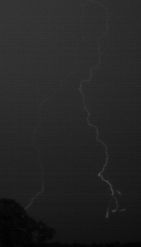Recent advances in video equipment allow videographers to capture high speed images of lightning. These cameras are capable of capturing many stages of the lightning flash that the human eye cannot discern. When played back in slow motion, stepped leaders, upward leaders, streamers, dart leaders, and return strokes can be seen. Figure 1 is an example of video from a high speed camera. This video was recorded at 4000 frames/second. Played back at 30 frames/second, 1 second of recorded video lasts 2 minutes and 13 seconds.
Although somewhat overexposed, this video shows a highly branched step leader approaching the ground. When one branch of the stepped leader makes a connection, a very bright return stroke surges upward through the channel. Note that the actual time between the appearance of the stepped leader in the cloud until the return stroke is about 1/133 of a second. Only one return stroke was recorded with this flash.
Figure 2 shows another stepped leader approaching the ground. Unlike the previous example, this video shows just two main channels of a stepped leader approaching ground. This video is less exposed than the previous example (which makes everything appear dimmer). In this case, the tips of the stepped leaders are racing toward the ground. The first to make a connection discharges the entire channel. Note that the actual time between the appearance of the stepped leader to the return stroke is about 1/50 of a second.
Figure 3 is the same as Figure 2, except played back at an even slower rate to show the apparent movement of the return stroke as the two channels are discharged.
Video contributed by Dr. Marcelo Saba, National Institute for Space Research, Brazil
Learn about Ground Currents or return to Contents page
|
Figure 1 |
 Figure2 Figure2 |
 Figure3 Figure3 |